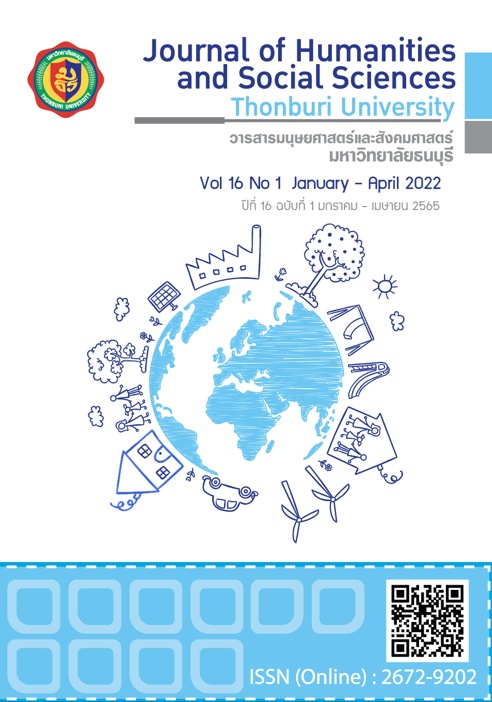การพัฒนากิจกรรมการเรียนรู้ด้วยผังมโนทัศน์ (Mind map) ร่วมกับเทคนิคเพื่อนช่วยเพื่อน วิชาการวิเคราะห์เชิงปริมาณเพื่อการตัดสินใจทางธุรกิจ สำหรับนักศึกษาชั้นปีที่ 3 หลักสูตรบริหารธุรกิจบัณฑิต มหาวิทยาลัยสงขลานครินทร์
คำสำคัญ:
ผังมโนทัศน์เสริม, เทคนิคเพื่อนช่วยเพื่อน, ประสิทธิภาพตามเกณฑ์ E1/E2บทคัดย่อ
การวิจัยครั้งนี้เพื่อพัฒนากิจกรรมการเรียนรู้ผังมโนทัศน์ร่วมกับเทคนิคเพื่อนช่วยเพื่อนวิชาการวิเคราะห์เชิงปริมาณเพื่อการตัดสินใจทางธุรกิจที่มีประสิทธิภาพ (E1/E2) ตามเกณฑ์ 80/80 เพื่อเปรียบเทียบผลสัมฤทธิ์ทางการเรียน รวมถึงศึกษาดัชนีประสิทธิผลของกิจกรรมการเรียนรู้ และศึกษาเจตคติของนักศึกษาที่มีต่อการจัดการเรียนการสอนวิชาวิเคราะห์เชิงปริมาณ ทำการทดลองกับนักศึกษาชั้นปีที่ 3 มหาวิทยาลัยสงขลานครินทร์ วิทยาเขตปัตตานี มีประชากร 32 คน เลือกกลุ่มตัวอย่างแบบเฉพาะเจาะจง ได้ 18 คน ใช้แผนการทดลองแบบ one group pre-test post–test design โดยการวัดผลสัมฤทธิ์ทางการเรียนก่อนและหลังการจัดกิจกรรมการเรียนรู้ โดยวิเคราะห์ข้อมูลวิเคราะห์ด้วยวิธี Paired – Samples T Test ผลการวิจัยมี ดังนี้
ผลการวิจัยพบว่า ประสิทธิภาพการจัดการเรียนรู้ด้วยผังมโนทัศน์ร่วมกับเทคนิคเพื่อนช่วยเพื่อนมีประสิทธิภาพของกระบวนการเรียน (E1) เท่ากับ 81.63 ซึ่งสูงกว่าเกณฑ์มาตรฐาน 80 ตัวแรก ประสิทธิภาพของผลลัพธ์ (E2) เท่ากับ 82.24 นักศึกษามีผลสัมฤทธิ์ทางการเรียนหลังเรียนสูงกว่าก่อนเรียนอย่างมีนัยสำคัญทางสถิติที่ .01 โดยมีคะแนนเฉลี่ยก่อนเรียนเท่ากับ 23.93 (S.D.=6.25) และหลังเรียนเท่ากับ 30.21 (S.D.=4.70) มีค่าดัชนีประสิทธิผลของการจัดการเรียนรู้เท่ากับ 0.63 สุดท้ายพบว่า นักศึกษามีเจตคติต่อการจัดการเรียนการสอนด้วยกิจกรรมการเรียนรู้ผังมโนทัศน์เสริมด้วยเทคนิคเพื่อนช่วยเพื่อนในภาพรวมเห็นด้วยจัดอยู่ระดับดีมาก
References
Wuthisatian, R., & Thanetsunthorn, N. (2019). Teaching macroeconomics with data: Materials for enhancing students’ quantitative skills. International Review of Economics Education, 30.
Srisampan, K., Sirisakulpaisan, B., & Foneboreman, S. (2017). Peer to peer learning in demonstration activity of child delivery process. Health Science Research Journal. 11(2):138-146.
Wongpattanakijmanop, k. (2019). Using mind-mapping technique and Plickers computer program to supplement the teaching and learning activities of a basic English course for 1st-year cadet. Class report. Military Prep School.
Komolmak, N. (2017). Learning outcomes of a peer-to-peer financial management course for 2nd-year high school students at Samsen College. (Master of EducationThesis, North Bangkok University).
Promwong, C. (2013). Media performance testing or teaching, Silpakorn Education Research Journal 5(1):7-20.
Bootdeewong, P., Aneksook, S., & Ngammeerit, N. (2019). Investigation into and development of an in-class pairing, peer to peer technique to improve learning achievement in mathematics of 11th-grade students in Princess Chulabhorn Science High School, Thailand. e-Journal of Education Studies, Burapha University. 1(3). September 2019.
Parndarong, B. (2017). Development of a peer-to-peer English for professional communication course at Lampang Technical College. (Master of EducationThesis, Chiangmai University).
Tanma, T. (2018). Learning outcomes of a peer-to-peer mixed-media course on fraction for 4th to 6th-year primary school students. 18th national Graduate studies of Northern Rajabhat University Network conference at Lampang RatchapatConference: Research and Development Department and Office of Graduate Study Administration, Lampang Ratchapat University.
Kaewmani, W. (2018). Development of creative English writing ability of 6th-grade students with mind mapping. Master’s degree dissertation, Faculty of Education, (Master of EducationThesis, Dhurakij Pundit University).
Buhmann, Y. S., & Kingsbury, M., (2015). A standardised, holistic framework for concept-map analysis combining topological attributes and global morphologies, Knowledge Management & E-Learning.7(1).
Downloads
เผยแพร่แล้ว
How to Cite
ฉบับ
บท
License
Copyright (c) 2021 มหาวิทยาลัยสงขลานครินทร์ ปัตตานี

This work is licensed under a Creative Commons Attribution-NonCommercial-NoDerivatives 4.0 International License.
ผลงานที่ปรากฎในวารสารฉบับนี้เป็นลิขสิทธิ์เฉพาะส่วนบุคคลของผู้เขียนซึ่งต้องรับผิดชอบต่อผลทาง กฎหมายที่อาจเกิดขึ้นได้และไม่มีผลต่อกองบรรณาธิการ





